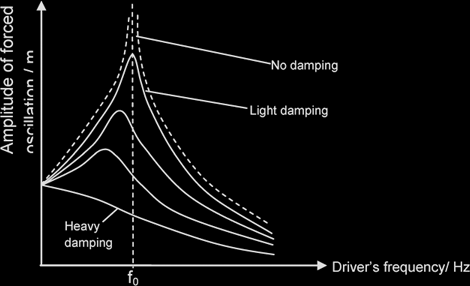Oscillations
Period: is defined as the time taken for one complete oscillation.
Frequency: is defined as the number of oscillations per unit time,
f = 1 / T
Angular frequency ω: is defined by the eqn, ω = 2 π f. It is thus the rate of change of angular displacement (measured in radians per sec)
Amplitude: The maximum displacement from the equilibrium position.
Phase difference φ: A measure of how much one wave is out of step with another wave, or how much a wave particle is out of phase with another wave particle.
φ = 2πx / λ = t / T x 2π {x =separation in the direction of wave motion between the 2 particles}
Simple harmonic motion: An oscillatory motion in which the acceleration {or restoring force} is
- always proportional to, and
- opposite in direction to the displacement from a certain fixed point / equilibrium position
ie a = -ω2 x (Defining equation of S.H.M)
| Time Equations | Displacement Equations |
|---|---|
| x = xo sinωt or x = xo cos (ωt), etc [depending on the initial condition] | |
| v = dx / dt = ωxo cosωt [assuming x = xosinωt] | v = ± ω √(xo2 - x2) [v - x graph is an ellipse] |
| a = -ω2x = -ω2(xosinωt) | a = -ω2x |
| KE = ½ mv2 = ½ m(ωxo cosωt)2 | KE = ½ mv2 = ½ mω2 (xo2 - x2) [KE - x graph is a parabola] |

The energy of the oscillator changes from potential to kinetic and back to potential in every half-cycle interval. At any point of its motion, the sum of the PE and KE is equal to the total energy. At the equilibrium position, the mass has a maximum KE because its speed is greatest and zero PE as the spring neither compressed nor stretched. At either A or B where the mass stops, its KE is zero while its PE is maximum.
The constant interchange of energies during SHM can be represented graphically as follows.

It can be shown that
total energy = maximum KE = maximum PE = ½mω2xo2
Damping: refers to the loss of energy from an oscillating system to the environment due to dissipative forces {eg, friction, viscous forces, eddy currents}
Light Damping: The system oscillates about the equilibrium position with decreasing amplitude over a period of time.
Critical Damping: The system does not oscillate & damping is just adequate such that the system returns to its equilibrium position in the shortest possible time.
Heavy Damping: The damping is so great that the displaced object never oscillates but returns to its equilibrium position very very slowly.
Free Oscillation: An oscillating system is said to be undergoing free oscillations if its oscillatory motion is not subjected to an external periodic driving force. The system oscillates at its natural freq.
Forced Oscillation: In contrast to free oscillations, an oscillating system is said to undergo forced oscillations if it is subjected to an input of energy from an external periodic driving force. The freq of the forced {or driven} oscillations will be at the freq of the driving force {called the driving frequency} ie. no longer at its own natural frequency.
Resonance: A phenomenon whereby the amplitude of a system undergoing forced oscillations increases to a maximum. It occurs when the frequency of the periodic driving force is equal to the natural frequency of the system.
Effects of Damping on Freq Response of a system undergoing forced oscillations
- Resonant frequency decreases
- Sharpness of resonant peak decreases
- Amplitude of forced oscillation decreases

Examples of Useful Purposes of Resonance
- Oscillation of a child's swing.
- Tuning of musical instruments.
- Tuning of radio receiver - Natural frequency of the radio is adjusted so that it responds resonantly to a specific broadcast frequency.
- Using microwave to cook food - Microwave ovens produce microwaves of a frequency which is equal to the natural frequency of water molecules, thus causing the water molecules in the food to vibrate more violently. This generates heat to cook the food but the glass and paper containers do not heat up as much.
- Magnetic Resonance Imaging (MRI) is used in hospitals to create images of the human organs.
- Seismography - the science of detecting small movements in the Earth‟s crust in order to locate centres of earthquakes.
Examples of Destructive Nature of Resonance
- An example of a disaster that was caused by resonance occurred in the United States in 1940. The Tarcoma Narrows Bridge in Washington was suspended by huge cables across a valley. Shortly after its completion, it was observed to be unstable. On a windy day four months after its official opening, the bridge began vibrating at its resonant frequency. The vibrations were so great that the bridge collapsed.
- High-pitched sound waves can shatter fragile objects, an example being the shattering of a wine glass when a soprano hits a high note.
- Buildings that vibrate at natural frequencies close to the frequency of seismic waves face the possibility of collapse during earthquakes.